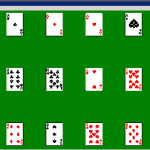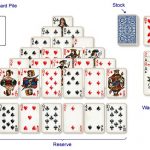Content Table:
Tri Peaks Solitaire Strategy Guide
Tri Peaks Solitaire is a fun and popular solitaire game that combines elements of Golf Solitaire and Pyramid Solitaire. It features an interesting scoring system, which can lead to much higher scores when you don’t play all the moves available to you.
Keys to Achieving a High Score
There are two keys to getting a high score in Tri Peaks Solitaire:
- Clear each Peak.
- Form long sequences.
Clearing a peak earns you significant points: 15 points for the first peak, 15 points for the second, and 30 points for the last peak. This totals 60 points, highlighting the importance of clearing all the peaks. Unless you can form an exceptionally long sequence, prioritizing the clearing of peaks is usually the best strategy.
Understanding the Scoring System
The second key to success in Tri Peaks Solitaire is to form long sequences without dealing from the talon (the draw pile). The scoring system awards you an additional point for every card you move in a sequence. For example, the first card moved gives you one point, the second card gives you two points, and so on. The sequence resets to one point if you deal from the talon.
This scoring system encourages players to delay moving cards until they can create a longer sequence, which can significantly increase your total score.
Illustrating the Scoring Difference
Consider the scoring difference between one long sequence of 12 cards versus two sequences of 6 cards. The long sequence would yield a score of:
1 + 2 + 3 + 4 + 5 + 6 + 7 + 8 + 9 + 10 + 11 + 12 = 78
In contrast, the two shorter sequences would score:
1 + 2 + 3 + 4 + 5 + 6 = 21 (for the first sequence)1 + 2 + 3 + 4 + 5 + 6 = 21 (for the second sequence)Total = 21 + 21 = 42
Even though the same number of cards were removed, the difference in scores is a staggering 36 points!
Extending Long Sequences
Now, if you could extend that long sequence of 12 cards to 14 cards, you would gain an additional:
13 + 14 = 27 points
Adding just two extra cards to the original sequence significantly increases your score, almost equaling the score from two shorter sequences!
Maximizing Your Strategy
It’s clear that forming one long sequence is crucial. Aim for a sequence of at least 10 cards to achieve a reasonable score. When starting a game of Tri Peaks Solitaire, you may find opportunities to form a long sequence early on, but rarely will it exceed 10 cards.
Before using that initial sequence, carefully analyze the tableau. Look at the cards above the bottom layer for potential long sequences. Observe any cards that cover those sequences, and prioritize removing those. Avoid playing cards that could extend your sequence just because they are playable, especially if they can be used in shorter sequences. The goal is to create the longest sequence possible to maximize your score.
Balancing Strategies
However, this strategy must be balanced against the need to uncover the peaks. Don’t hold on too long for that perfect sequence at the expense of clearing the peaks.
By keeping these strategies in mind and practicing regularly, you’ll soon see your scores in Tri Peaks Solitaire increase significantly!



